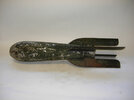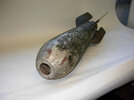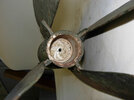This is a VietCong recoiless rifle round. In mid to late 60s they were found along rivers and streams, but also used in the attack. Thewre were models that used dud US 105mm rounds. These used the same propelling system as the B 50 did.
Type. This is a fin stabilized, antipersonnel projectile mounted on a wooden stick. The projectile is
probably fired from a recoiless rifle launcher. A delay fuze is used with this projectile.
Painting and Markings.
Features.
Three circumferential grooves are cut in the base end of the stick. An end cap is nailed on
the base of the stick.
DESCRIPTION.
Material. The projectile body and fins are steel. The stick is wood. The windshield of the fuze is sheet
metal, and the fuze body may be aluminum or steel.
Weight. The projectile with fuze weighs approximately 45 pounds.
Arrangement. The internal arrangement of the projectile can be that of typical U.S. 105-mm projectiles. The fuze consists a Viet Cong firing mechanism and windshield.
Hazardous Components
The body of the projectile is filled with approximately 5 pounds of composition. The fuze utilizes a blasting
cap as a detonator, and granulated TNT (quantity unknown) as a booster. The quantity and composition
of the materials in the safety fuse and primer are unknown. An auxiliary detonating fuze (ADF) containing a 25-gram tetryl booster may be present.
Arming and Firing Function
The safety wire is removed from the fuze prior to firing. Upon setback, the striker overcomes the
anticreep spring and strikes the percussion primer which, in turn, ignites the safety fuse. After a 5- to
7-second delay, the safety fuse ignites the blasting cap, initiating the explosive train.




